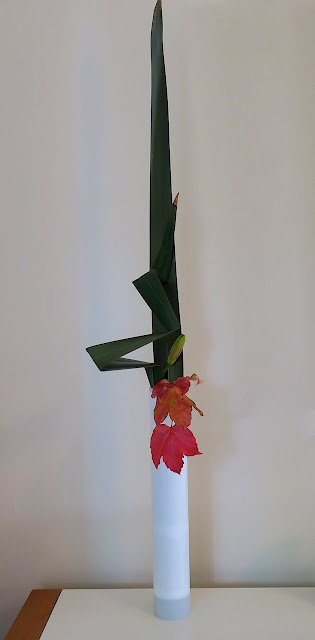Recently, I set my Melbourne students the task of making a freestyle ikebana using large leaves with a floral focus.
In a white suiban, Marisha placed two Monstera leaves, the taller of which she curved back to show the veins on the underside. A cave-like space was thus created, into which she placed a pink Camellia as though it was sheltering. The only kenzan she had was black, so it was covered with white tissue. At the time of taking the photo, water had not yet been added to the vessel.
Last winter my student Jo and her husband gave me the pruned branches of a weeping elm from their garden, and delivered them to my house. The arching lines of these branches are particularly interesting because the subsequent curves of their side branches create a repeating effect. At the time of asking I did not have a specific plan for their use. However, I was confident I would eventually find one. My recent demonstration for the Geelong Gallery was the perfect opportunity.
I began with two branches, exploring ways to position them relative to each other. Their drooping ends were exceptionally long, straight and brittle, which made a purely naturalistic placement impossible. The resulting ikebana would have been too tall, and I could not transport the elements in my small car. The above photo shows a moment when the branches appeared to be twisting around each other.
This is the final Ikebana. The two branches arise from a large ceramic 'half pillow' form. The ends of those on the left have been allowed to form sweeping lines. Those on the right have been cut straight across to the same length. Securing of the branches together has been achieved using three wooden dowels, two of which are made from bamboo skewers. In the central space between the branches I placed two short Gymea leaves Doryanthes palmeri and a mass of red Nandina "Nana". Both of these fresh materials will last without water for some time.
The full width of the ikebana is 2.1m and the height 1.4m.
The ceramic 'half pillow' was created by Graham Wilkie.
Greetings from Christopher
16th June 2024








No comments:
Post a Comment